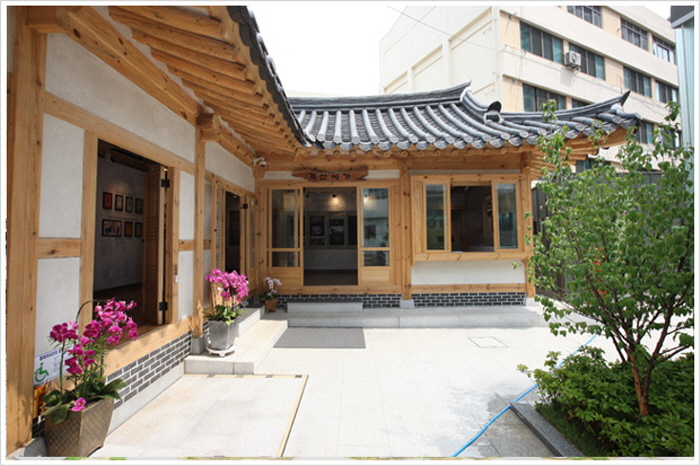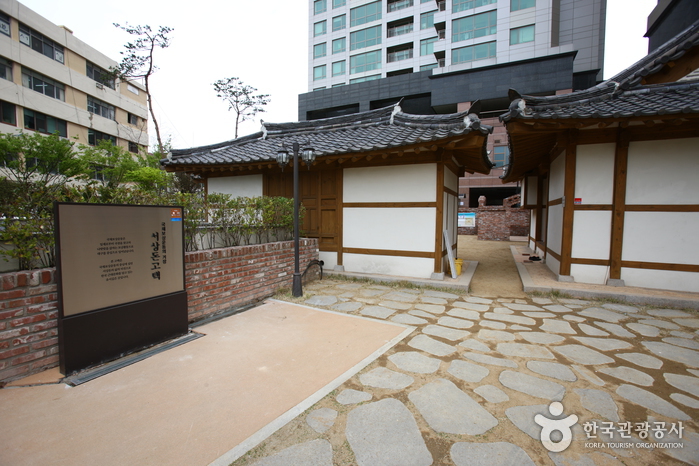Daegu Jeil Church (대구제일교회)
4.2Km 2024-10-11
50, Gukchaebosang-ro 102-gil, Jung-gu, Daegu
+82-53-253-2615
Daegu Jeil Church is the oldest Protestant Church in Gyeongsangbuk-do Province. Initially established in 1898 over four tile-roofed houses, Daegu Jeil Church was rebuilt in 1933 with traditional and Western architectural designs. Subsequently, Deacon Lee Ju-Yeol dedicated a 33m bell tower in 1937, whlie the church underwent an interior renovation in 1969, and an expansion in 1981.
In conjuction with its physical development, which was at the forefront of the nation's architectural modernization, the church contributed largely to modernization and expansion of Christianity in the region as well as in Korea. In addition, by introducing modern medicine and education to the citizens of Daegu, the founders of Daegu Jeil Church stimulated social development in the region.
Gyonam YMCA (교남YMCA)
4.3Km 2023-01-20
22, Namseong-ro, Jung-gu, Daegu
Established in December 1921, the Gyonam YMCA Hall served as a gateway to the modern movement in Daegu. During the Japanese colonial period, it was a meeting place and a base for Christian national movements such as the Product Promotion Movement, the Christian Rural Movement, and the Singanhoe Movement. This hall is a two-story red brick building built by the American missionary Blair in 1914. It retains the characteristics of the 1910s and '20s masonry construction, such as decorating the first and second floors with cornices and securing a square window with arches. In the early days, it was used as a place for students' education, evening classes, and lectures.
House of Yi Sang-hwa (이상화 고택)
4.4Km 2023-01-06
6-1, Seoseong-ro, Jung-gu, Daegu
+82-53-256-3762
Yi Sang-hwa was a nationalist poet, who resisted the Japanese colonialism. This was his house from 1939 until his death in 1943. His house was neglected after he died, until a citizens' movement in 1999 to preserve the house urged the Military Mutual Aid Association to purchase it, and donate it to the City of Daegu on October 27, 2005. It has been restored and opened to the public, serving as the center for education of the poet's brave spirit and work.
Daegu Gyesan Cathedral (대구 계산동성당)
4.4Km 2024-07-31
10 Seoseong-ro, Jung-gu, Daegu
+82-53-254-2300
Daegu Gyesan Cathedral is one of Daegu's main churches, designed by Father Poisnel, who also designed Myeongdong Cathedral and imported stained glass for the windows directly from France. Being located in the city center, the cathedral is especially beautiful when seen at night.
Modern History Experience Hall Gyesanyega (근대문화체험관 계산예가)
4.4Km 2021-04-27
6-1, Seoseong-ro, Jung-gu, Daegu
+82-53-661-3323
Modern History Experience Hall Gyesanyega opened in 2012 is a public space designed for rest and education. Visitors can enjoy a moment of relaxation while touring Daegu Modern Culture Alley, as well as learn more about the history of the area through the video hall and about the houses featured along the way, such as House of Yi Sang-hwa and House of Seo Sang-don, at the hanok exhibition hall.
House of Seo Sang-don (서상돈 고택)
4.4Km 2021-07-01
6-1, Seoseong-ro, Jung-gu, Daegu
+82-53-256-3762
The house of entrepreneur and activist Seo Sang-don is located in the heart of Daegu. In 1907, in an effort to repay national debt and to gain independence from Japan, Seo launched the National Debt Repayment Movement as well as a nationwide campaign calling for people to quit smoking.
In celebration of Seo's leadership, the City of Daegu restored Seo's old house and opened it to the public. The City also built the National Debt Repayment Park and erected a statue of Seo in his honor.
Olive Young - Daegu Chimsan Branch [Tax Refund Shop] (올리브영 대구침산)
4.4Km 2024-04-17
124, Chimsan-ro, Buk-gu, Daegu
-
Hotel Ariana (호텔 아리아나)
4.5Km 2021-01-22
27, Dongdaegu-ro, Suseong-gu, Daegu
+82-53-763-9000
Located right next to Daegu Suseong Recreation Area, Hotel Ariana's interior is decorated in a European-style with deep blue shades of trees and a Western-style service attending to its business guests for a comfortable vacation. The hotel offers a modern European interior in each of the 50 guest rooms; Daegu's first authentic European draft beer, brewed conveniently at the hotel; and a number of events and concerts held at the Suseong Lakeshore nearby for a beautifully memorable trip.
ER NC Outlets - EXCO Branch [Tax Refund Shop] (ER NC아울렛 엑스코)
4.5Km 2024-04-22
22, Yutongdanji-ro 14-gil, Buk-gu, Daegu
-
E-Mart - Chilseong Branch [Tax Refund Shop] (이마트 칠성)
4.5Km 2024-04-23
93, Chimsan-ro, Buk-gu, Daegu
-



![Olive Young - Daegu Chimsan Branch [Tax Refund Shop] (올리브영 대구침산)](http://tong.visitkorea.or.kr/cms/resource/36/2888036_image2_1.jpg)
![ER NC Outlets - EXCO Branch [Tax Refund Shop] (ER NC아울렛 엑스코)](http://tong.visitkorea.or.kr/cms/resource/10/2883910_image2_1.jpg)
![E-Mart - Chilseong Branch [Tax Refund Shop] (이마트 칠성)](http://tong.visitkorea.or.kr/cms/resource/99/2888199_image2_1.jpg)
 English
English
 한국어
한국어 日本語
日本語 中文(简体)
中文(简体) Deutsch
Deutsch Français
Français Español
Español Русский
Русский